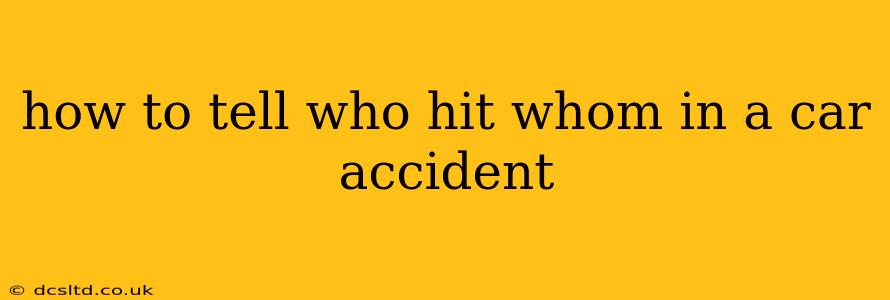How to Tell Who Hit Whom in a Car Accident
Determining fault in a car accident can be complex, even with seemingly straightforward circumstances. Understanding the contributing factors is crucial for insurance claims and potential legal action. This guide breaks down how to assess impact, focusing on evidence gathering and understanding legal implications.
Important Disclaimer: This information is for educational purposes only and should not be considered legal advice. Always consult with legal professionals and your insurance company after any accident.
Immediate Post-Accident Actions:
Before anything else, prioritize safety. If anyone is injured, call emergency services immediately. Once the scene is secure:
- Call the police: A police report is invaluable. It provides an official record of the accident, including witness statements and the officer's assessment of the scene.
- Take photos and videos: Document everything – damage to vehicles, skid marks, traffic signs, road conditions, and the surrounding area. Capture multiple angles and perspectives.
- Gather information: Exchange information with the other driver(s) and any witnesses. This includes names, contact information, driver's license numbers, insurance details, and license plate numbers.
- Note down details: Write down your own observations of the accident, including the time, location, weather conditions, and your version of events. Be as detailed as possible.
Determining Impact: Evidence Analysis
Several factors can help determine who hit whom:
- Vehicle damage: The location and severity of the damage on each vehicle can offer clues. For instance, damage concentrated on the front of one car and the rear of another strongly suggests who initiated the collision. However, this isn't always definitive. A side impact might indicate a failure to yield or a lane change collision.
- Skid marks: The length and direction of skid marks can indicate speed and braking behavior before the impact. Expert analysis might be necessary for interpretation.
- Witness testimonies: Eyewitness accounts can provide crucial information about the events leading up to and during the collision. However, remember that eyewitness accounts can be subjective and unreliable.
- Traffic cameras and dashcams: Footage from security cameras, traffic cameras, or dashcams can provide objective evidence of the accident.
- Physical evidence at the scene: Debris patterns, tire tracks, and the final resting positions of the vehicles can help reconstruct the events.
What if there are conflicting accounts?
If there are conflicting accounts or unclear evidence, the process becomes more challenging. Insurance adjusters will investigate, examining all available evidence. In some cases, accident reconstruction specialists may be needed to analyze the physics of the collision and determine fault.
Who is usually at fault? Common accident scenarios:
- Rear-end collisions: The driver who rear-ended the other vehicle is typically at fault, unless the driver ahead made a sudden stop without proper signaling.
- Intersection collisions: Determining fault in intersection collisions depends on who had the right-of-way. Factors like traffic signals, stop signs, and the drivers' actions are considered.
- Side-swipe collisions: Usually, the driver who changes lanes unsafely is at fault.
- Hit and run accidents: The driver who fled the scene is obviously at fault and may face criminal charges in addition to civil liability.
What if I'm unsure who hit whom?
If you are unsure of who hit whom, the best course of action is to cooperate fully with the police investigation and your insurance company. Provide all the evidence you have gathered and let the professionals determine liability.
Legal Implications and Insurance Claims
Understanding the legal aspects is crucial. Your insurance company will investigate the accident to determine liability. If you are found at fault, your insurance premiums might increase, and you may be responsible for the other driver's damages. If the other driver is at fault, their insurance company should cover your damages. A lawyer can guide you through the process.
By meticulously documenting the accident scene and gathering all available evidence, you can increase the likelihood of a fair and accurate determination of fault. Remember, professional assistance from legal and insurance professionals is highly recommended after any accident.
